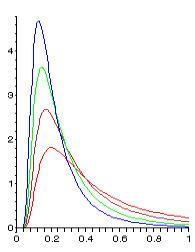 | ||
Parameters ν > 0 {\displaystyle \nu >0\!} Support x ∈ ( 0 , ∞ ) {\displaystyle x\in (0,\infty )\!} PDF 2 − ν / 2 Γ ( ν / 2 ) x − ν / 2 − 1 e − 1 / ( 2 x ) {\displaystyle {\frac {2^{-\nu /2}}{\Gamma (\nu /2)}}\,x^{-\nu /2-1}e^{-1/(2x)}\!} CDF Γ ( ν 2 , 1 2 x ) / Γ ( ν 2 ) {\displaystyle \Gamma \!\left({\frac {\nu }{2}},{\frac {1}{2x}}\right){\bigg /}\,\Gamma \!\left({\frac {\nu }{2}}\right)\!} Mean 1 ν − 2 {\displaystyle {\frac {1}{\nu -2}}\!} for ν > 2 {\displaystyle \nu >2\!} Mode 1 ν + 2 {\displaystyle {\frac {1}{\nu +2}}\!} | ||
In probability and statistics, the inverse-chi-squared distribution (or inverted-chi-square distribution) is a continuous probability distribution of a positive-valued random variable. It is closely related to the chi-squared distribution and its specific importance is that it arises in the application of Bayesian inference to the normal distribution, where it can be used as the prior and posterior distribution for an unknown variance.
Contents
Definition
The inverse-chi-squared distribution (or inverted-chi-square distribution ) is the probability distribution of a random variable whose multiplicative inverse (reciprocal) has a chi-squared distribution. It is also often defined as the distribution of a random variable whose reciprocal divided by its degrees of freedom is a chi-squared distribution. That is, if
The first definition yields a probability density function given by
while the second definition yields the density function
In both cases,
Differential equation
